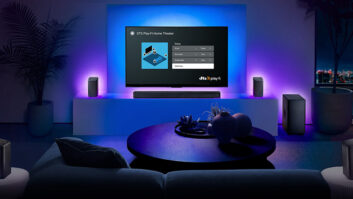“Young Frankenstein” and “One Flew Over the Cuckoo’s Nest” come to mind whenever someone talks to me about putting an electrode-embedded headcap on your head. But that’s just what the mad scientists at DTS did to make the point that improving a tablet’s audio quality will improve the mobile entertainment experience more than improving video quality.
For its experiments on human subjects, DTS hired Neuro-Insight, a “neuromarketing” company that measures consumers’ responses to communications. Neuro-Insight placed headcaps with 28 sensors on 107 people to map their brains’ electrical activity when presented with four different pieces of video content. Each piece was played back with three levels of video quality (240p, 480p and 1080p) on a 10-inch Samsung tablet with 1080p screen. The company also tested brain activity when the subjects watched the videos while listening to the videos’ audio through ear buds in 96Kbps stereo and in 256Kbps DTS Headphone:X technology.
DTS Headphone:X technology widens the stereo image, pushes the soundstage above and around the listener, and tunes response to specific brands of headphones. It also delivers a surround-sound experience through headphones when playing back multichannel soundtracks encoded with the DTS-HD audio codec.
Neuro-Insight played back the content in random order and mapped the electrical activity of the subjects’ brains on a second-by-second basis. The company didn’t ask subjects to verbalize their preferences.
The subjects were men and women ages 18 to 35, all said to be regular users of smartphones and tablets for mobile entertainment.
“When we switched to enhanced audio, the patterns of brain activity seen were similar to those seen when we eat something we find enjoyable, hear a funny joke or, for that matter, [anticipate] the ‘high’ associated with an addictive drug,” said Neuro-Insight CEO Pranav Yadav. “Increasing the video quality did not achieve the same results or reactions.”
Tablet users, he continued, “simply liked the content a lot more with Headphone:X audio, even when the video quality was not as high, as compared to seeing the same visual stimulus with higher quality video but ordinary audio.”
Playing back video at three quality levels produced no statistical change in neuro activity as quantified by the company’s hedonic index. The index results were 0.55, 0.54 and 0.55, respectively. On the other hand, switching from 96Kbps stereo to 256Kbps Headphone:X boosted the index to 0.64 from 0.45 for a 42 percent increase.
The biggest increase in the index — 66 percent — came when Headphone:X was added to medium-quality (480p) video. Adding Headphone:X to low-quality video (240p) generated a 19 percent gain, while adding Headphone:X to 1080p video yielded a 35 percent gain.
The lesson for mobile-device makers, content providers, and wireless carriers — other than work together to promote or adopt Headphone:X — is to concentrate on improving audio for mobile devices. Audio improvements eat up a lot less bandwidth than improved video at a much lower cost, DTS said. “Operators who re-balance their use of bandwidth to offer enhanced audio will not only save money, but they will also deliver an immediate improvement in the customer experience,” said Geir Skaaden, DTS’s audio technology senior VP.
Headphone:X increases bandwidth consumption by 15 percent and boosts enjoyment by 66 percent when viewing 480p video, but going from 480p to 1080p video while maintaining 96Kbps audio quality delivers only a 2 percent improvement in enjoyment, Skaaden said.
At least one smartphone vendor must have heard a difference. Chinese vendor Vivo shipped the first smartphone with Headphone:X, though for the Chinese market.













